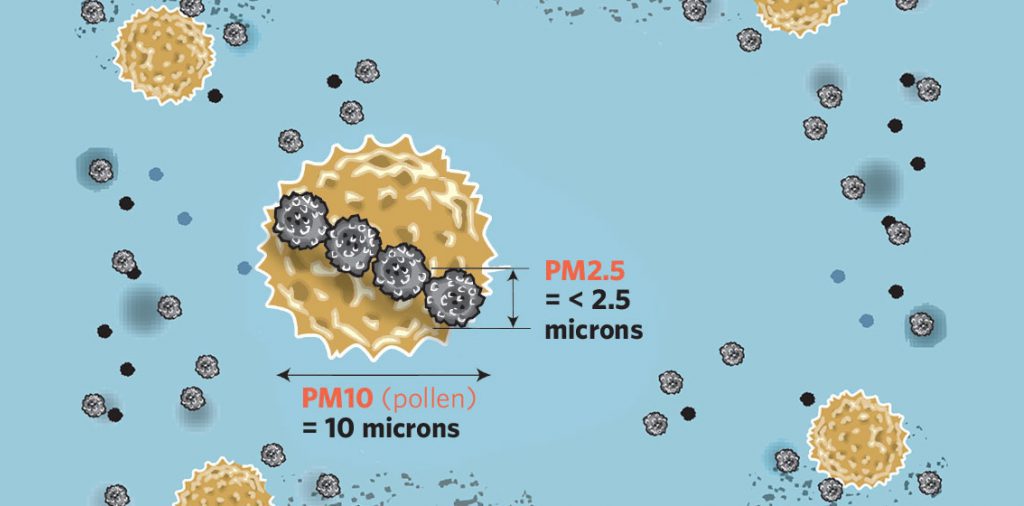Ozone and PM2.5 are the region’s biggest air hazards
The heavy smoke is gone. But particulates 30 times smaller than the diameter of a human hair and gases formed by the reaction of sunlight and fossil fuels exhaust remain as the region’s most widespread, stubborn and dangerous air quality problems.
Unlike the smoke that draped large swaths of southwestern Pennsylvania during its industrial heyday, fine airborne particulates known as PM2.5 and ground-level ozone are barely visible. Both raise serious health risks.
And both are among the six major “criteria” air pollutants that the U.S. Environmental Protection Agency considers the largest-scale threats to air quality in the nation and attempts to reduce with regulations based on scientific evidence of their potential to damage human health.
Air toxics, such as benzene, dioxin and mercury, are also recognized as serious airborne health risks and are regulated by federal air quality laws. But their risks tend to be more concentrated on communities nearest their sources, unlike ground-level ozone and PM2.5, both of which can ride the breeze for hundreds of miles.
Lingering smog
Ground-level ozone, or smog, is the most common air pollutant found in the more urbanized northeastern states, including the Pittsburgh Metropolitan Statistical Area. The reason is clear: its most prolific sources include exhaust from cars, trucks, buses and industrial plants that reacts with sunlight to form the gas, which most often happens in the summer.
Short-term exposure is a known trigger of asthma attacks, while long-term exposure contributes to reduced lung function, other respiratory ailments and heart disease.
All seven of the Pittsburgh MSA counties fail to meet the current federal standard for ground-level ozone, which was ratcheted tighter in 2015.
Microscopic menace
PM2.5 is particulate matter that is less than 2.5 micrometers in diameter and appears only as a faint haze when highly concentrated and illuminated by sunlight.
Emissions from coal-burning power plants, steel and coke plants, cars, trucks and buses mix to form the fine particulates known to travel freely and widely. Less prolific sources of such emissions include wood stoves and restaurant fryers.
It’s the microscopic stature of PM2.5 that makes it so dangerous to people who breathe it. PM2.5 is able to evade the respiratory mucous membranes of the nasal passage and other natural defenses, make its way deep into the lung, enter the blood stream and travel to other organs. And a large and expanding body of science reports the extent of the harm it can cause.
Both short– and long-term exposure can reduce lung function and increase the risk of lung and heart disease, cancers and premature death. Studies show it aggravates asthma. Even short-term exposure increases the risk of heart attack and arrhythmias among people with heart disease.
Its size also makes it one of the most mobile air pollutants. The tiny particles have more surface area compared to their mass, which quickly balances the drag against their surface and allows them to settle into equilibrium. In other words, they’re almost immune to gravity. Suspended in the air, they ride the breeze until flushed out by rain. It’s possible, then, that during a rainless week, PM2.5 riding light five mile-per-hour breezes can travel more than 800 miles.
That particular characteristic is troubling for southwestern Pennsylvania, where prevailing winds offer an airborne route into the region for PM2.5 formed from sulfur dioxide and other emissions released from a network of coal-fired power plants and other sources in the Ohio River Valley.
Such qualities led the U.S. Environmental Protection Agency to include PM2.5 among the major “criteria” air pollutants regulated under the Clean Air Act. Southwestern Pennsylvania continues to struggle to attain compliance of PM2.5 pollution standards, which requires all counties to show levels within the prescribed limits over a three-year period.
Hottest of hot spots
Air monitors directly downwind of the U.S. Steel Clairton coke works have recorded some of the highest concentrations of PM2.5 in the region and nation for decades. Even after levels tumbled from an annual average of 23 micrograms per cubic centimeter in 1997 to less than 13 in 2015, the Liberty Borough monitor near the coke works still reports levels higher than the current federal standard for PM2.5.
That lingering hot spot is the chief reason Allegheny County is the only county in the seven-county Pittsburgh Metropolitan Statistical Area in nonattainment of the current annual PM2.5 standard 12 micrograms per cubic centimeter. Only 19 of more than 3,100 counties in the United States fail to meet that mark.





